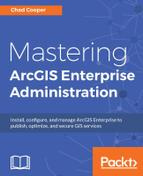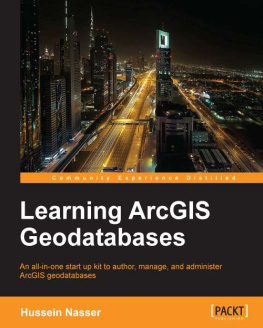Price Maribeth - Mastering ArcGIS Pro, 2e
Here you can read online Price Maribeth - Mastering ArcGIS Pro, 2e full text of the book (entire story) in english for free. Download pdf and epub, get meaning, cover and reviews about this ebook. year: 2022, publisher: McGraw-Hill US Higher Ed ISE, genre: Politics. Description of the work, (preface) as well as reviews are available. Best literature library LitArk.com created for fans of good reading and offers a wide selection of genres:
Romance novel
Science fiction
Adventure
Detective
Science
History
Home and family
Prose
Art
Politics
Computer
Non-fiction
Religion
Business
Children
Humor
Choose a favorite category and find really read worthwhile books. Enjoy immersion in the world of imagination, feel the emotions of the characters or learn something new for yourself, make an fascinating discovery.
- Book:Mastering ArcGIS Pro, 2e
- Author:
- Publisher:McGraw-Hill US Higher Ed ISE
- Genre:
- Year:2022
- Rating:5 / 5
- Favourites:Add to favourites
- Your mark:
- 100
- 1
- 2
- 3
- 4
- 5
Mastering ArcGIS Pro, 2e: summary, description and annotation
We offer to read an annotation, description, summary or preface (depends on what the author of the book "Mastering ArcGIS Pro, 2e" wrote himself). If you haven't found the necessary information about the book — write in the comments, we will try to find it.
Mastering ArcGIS Pro, 2e — read online for free the complete book (whole text) full work
Below is the text of the book, divided by pages. System saving the place of the last page read, allows you to conveniently read the book "Mastering ArcGIS Pro, 2e" online for free, without having to search again every time where you left off. Put a bookmark, and you can go to the page where you finished reading at any time.
Font size:
Interval:
Bookmark:

Page i
Second Edition
Maribeth H. Price
South Dakota School of Mines and Technology
Mastering ArcGIS Pro

Page ii

MASTERING ArcGIS PRO
Published by McGraw Hill LLC, 1325 Avenue of the Americas, New York, NY 10019. Copyright 2023 by McGraw Hill LLC. All rights reserved. Printed in the United States of America. No part of this publication may be reproduced or distributed in any form or by any means, or stored in a database or retrieval system, without the prior written consent of McGraw Hill LLC, including, but not limited to, in any network or other electronic storage or transmission, or broadcast for distance learning.
Some ancillaries, including electronic and print components, may not be available to customers outside the United States.
This book is printed on acid-free paper.
1 2 3 4 5 6 7 8 9 LMN 27 26 25 24 23 22
ISBN 978-1-265-12771-8
MHID 1-265-12771-9
Cover Image: Maxiphoto/Getty Images
All credits appearing on page or at the end of the book are considered to be an extension of the copyright page.
The Internet addresses listed in the text were accurate at the time of publication. The inclusion of a website does not indicate an endorsement by the authors or McGraw Hill LLC, and McGraw Hill LLC does not guarantee the accuracy of the information presented at these sites.
mheducation.com/highered
Page iii
Page iv
Page v
Page vi

Page vii
Welcome to Mastering ArcGIS Pro, a detailed primer on learning the latest ArcGIS software by Esri, Inc. This book is designed to offer everything you need to master the basic elements of GIS.
Notice: ArcGIS Pro, ArcGIS, ArcMap, ArcCatalog, ArcGIS Desktop, ArcInfo Workstation, and the other program names used in this text are registered trademarks of Esri, Inc. The software names and the screen shots used in the text are reproduced by permission. For ease of reading, the symbol has been omitted from the names; however, no infringement or denial of the rights of Esri is thereby intended or condoned by the author.
Although the concepts of GIS have remained fairly constant over time, the software is continually evolving. With the release of ArcGIS Pro, the latest software in the Esri GIS family, a new generation of GIS has arrived. ArcGIS Pro has a 64-bit, multithreaded architecture, uses ribbon-style menus, integrates 2D and 3D applications, and is closely tied to ArcGIS Online.
The Mastering ArcGIS Pro series represents a major revision of Mastering ArcGIS, a book that covered GIS concepts and skills using the ArcGIS Desktop programs of ArcMap and ArcCatalog. Although the GIS concepts largely remain the same in both texts, the implementation, and in some cases the terminology, has changed. The new software prompted a reorganization of the book in the first edition, and the second edition has retained these changes.
First, the book has been refocused on the basics of GIS. Partly for this reason, and partly to better match the rhythm of a semester, the book is now presented in 12 chapters, leaving time for instructors to better incorporate exams and projects within the semester. Some of the more advanced and less frequently used skills, such as planar topology and standards-based metadata, have been left for students to explore on their own. The ArcGIS Pro software capabilities and interface are continuing to evolve. Although the basic capabilities of ArcGIS Pro have not much changed since the first edition, the interface has many small changes. This second edition has been updated to reflect many small changes to the interface between versions 2.2 and 2.8.
Second, the book includes some new topics. Raster data management has been discussed in a new chapter to acquaint students with compiling and processing raster data sets, supplementing a similar chapter on vector data management. ArcGIS Pro was designed to foster the sharing of GIS data and workflows, and these enhanced capabilities are explored in another new chapter, including how to prepare a database for collecting data using mobile devices.
Third, the chapters and topics have been reorganized to eliminate some repetition and to present the information more logically. The text still roughly follows the project model with data management presented first and analysis second.
The tutorials, questions, and exercises were rewritten in the first edition. The second edition edits mainly deal with the many small changes to the interface. Some of these changes are minor but ubiquitous (such as the change of a button name). In such cases I have changed the text and the first video or two to reflect the differences, but left subsequent videos unchanged.
In the first edition, I have tried to incorporate more open-ended and creative questions in the exercises, rather than relying on cut-and-dried questions and answers. Although this approach makes grading a little harder for instructors, I believe it enhances student learning and makes the exercises more interesting. The second edition questions and exercises have remained the same. The data distributed with the text have not changed from the first edition.
I would like to thank the many people who have used and commented on Mastering ArcGIS, and I have tried to take those lessons to heart. I hope that this text continues to serve their needs in the rapidly evolving world of GIS.
Page viii
This book assumes that the reader is comfortable using Windows to carry out basic tasks such as copying files, moving directories, opening documents, exploring folders, and editing text and word processing documents. Previous experience with maps and map data is also helpful. No previous GIS experience or training is necessary to use this book.
This learning system includes a textbook and web site, including
Twelve chapters on important concepts in GIS data management and analysis
Comprehensive tutorials in every chapter to learn the skills, with each step demonstrated in a video clip
A set of exercises and data for practicing skills independently
This book assumes that the student has access to ArcGIS Pro and an organizational account for ArcGIS Online. The Spatial Analyst extension is required for .
This text reflects the authors personal philosophies and prejudices developed from 25 years of teaching GIS at an engineering school. The main goal is not to train geographers but to provide students in any field with GIS skills and knowledge. It is assumed that most students using this book already have a background of discipline-specific knowledge and skills upon which to draw and are seeking to apply geospatial techniques within their own knowledge domains.
Concepts and skills are both important. Students must be able to understand the geographic and database concepts that are integral to spatial data management and analysis. It is not enough to know a series of software steps; one should understand the why behind them.
Font size:
Interval:
Bookmark:
Similar books «Mastering ArcGIS Pro, 2e»
Look at similar books to Mastering ArcGIS Pro, 2e. We have selected literature similar in name and meaning in the hope of providing readers with more options to find new, interesting, not yet read works.
Discussion, reviews of the book Mastering ArcGIS Pro, 2e and just readers' own opinions. Leave your comments, write what you think about the work, its meaning or the main characters. Specify what exactly you liked and what you didn't like, and why you think so.






